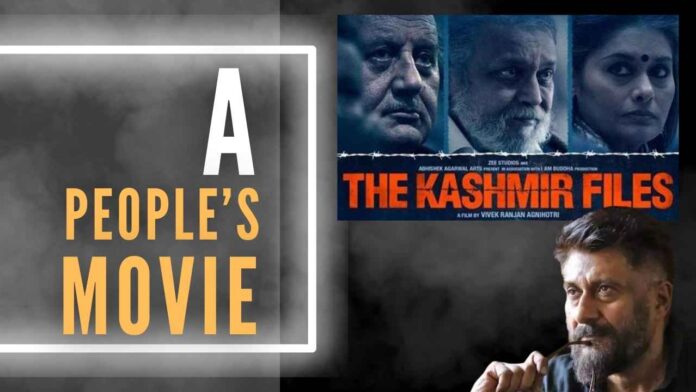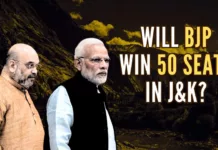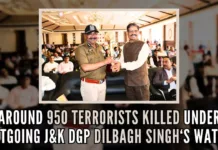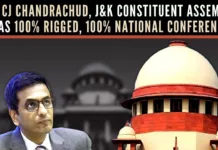
The saga of Kashmir 1990 and after
Movies rarely have the power to move a nation. ‘The Kashmir Files‘ has done exactly that.
Vivek Ranjan Agnihotri’s moving saga `The Kashmir Files’ has opened to overwhelming response worldwide, especially from the Kashmiri Hindu diaspora. Indian diaspora is extremely unsettled after watching the movie, their suppressed grief coming to the fore. Anger and emotions are overflowing, they demand, when can they see their beloved Kashmir.
The heart-wrenching brilliantly made movie, in a back-story technique, unfolds in a calibrated manner. Interestingly, some of the incidents woven into the story are somewhat familiar, narrated by Kashmiri Hindus who lived through the genocide. The movie shows how Islamist jihadis systematically boycotted, sidelined, starved, and spread hatred against the minority `kafir’ Hindu community in Kashmir valley; with persistent shrill cries of Ralive, Tsalive ya Galive (Convert to Islam, leave the place or die), openly announcing that Hindu men can leave, whereas women can stay back to be converted or raped, the frenzy building up to the calamity of 19th Jan 1990, which led to mass killings and rapes of Hindus. It depicts gruesome killings weaved with bone-chilling true facts in a stark white snow-filled frozen landscape; friends and neighbors of centuries with whom Hindus dined and celebrated their festivals turned into abettors in the jihad.
The director carefully crafts the movie and deftly handles the explosive subject. The movie is realistic and gritty, with many dialogues in Kashmiri with English subtitles. Sharada, sublimely played by Bhasha Sumbli, a mother of two, the main fulcrum in the movie is fed her husband’s blood-soaked rice to save her child, and the killer terrorist was a student of her father-in-law. In a series of flashbacks, the displaced lakhs of Kashmiri Hindus surviving in horrid conditions in tents outside Kashmir valley are yet again savagely killed by terrorists disguised in army fatigues in later years. Sharada is bodily sawn and killed after being disrobed by the terrorists, her young elder son who witnesses the horror is also shot dead along with 23 others. In another poignant scene, the popular Hindu poet Sarvinder Premi Kaul who gives shelter to Hindu women in the middle of the freezing night is deceived by the jihadis, he and his son are brutally killed and hung from the trees, the whole scene looks macabre and ghost-like. The movie mentions Hindu mass graves filled with over 7000 bodies.
The movie unfolds through the eyes of a JNU student Krishna, the younger son of Sharada, and grandson of Pushkarnath Pandit, brilliantly played by Darshan Kumar, who is contesting to become Students Union President; and through the recollections of Pushkarnath Pandit’s old friends, an ensemble veteran cast in a cozy setting. Anupam Kher, a Kashmiri himself, lives on the screen as Pushkarnath Pandit, old and fragile yet with indomitable spirit fighting against Article 370. His growing discomfiture with his young grandson’s anti-national politics is well-portrayed. In yet another inspired casting, Pallavi Joshi plays the JNU professor who is busy indoctrinating her students in the now-familiar `Azadi’ lingo, out to liberate Kashmir from `Indian occupation’, and the academia’s deep connections with secessionists networks. The remarkably clever use of Faiz Ahmed Faiz’s iconic song `hum dekhenge’, turns the tables against the fake propagandists.
Vivek Agnihotri doesn’t shy away from addressing false narratives and is brutally honest with his filming. He rightly calls out Jihad for what it is, clearly spells out Hindu Genocide, unshackling it from the euphemistic `Exodus’, clearly establishes the collusion of J&K govt with the terror networks, and Indian govt’s complete inaction and even looking the other way to prove its secular credentials. He also shows how the administration actively collaborated with the jihadi killers, the deafening silence of national and international media to the unfolding Hindu genocide, and the plight of over 5 lakhs Hindus who ran away for their lives, leaving their houses properties, and businesses behind. Even today, the Indian nation doesn’t acknowledge the plight of `driven and displaced’ Kashmiris Hindus.
The Deafening Silence
For a clearer understanding of timelines, Kashmir’s latest Hindu genocide in the late 1980s and 1990, was around the same time, that the disputed structure ‘Babri masjid’ was pulled down in Ayodhya, followed by the Mumbai riots of 1993 triggered by terrorists. Even though it was not the age of social media, the above events were systematically written up and played out by national and international media, yet Indian media doesn’t inform Indians about the Kashmiri Hindu genocide. It was similarly silent during the events leading up to the 1947 partition, freedom, and after, yet for some unfathomable reasons, the media’s role in the freedom struggle is often glorified.
Politically too, no questions were asked of the then central govt, possibly because Mufti Mohd Sayeed, a Kashmiri, was the first Muslim Home Minister of India. He himself went on to become CM again in J&K and died in office in 2016. It’s a damning indictment on the Indian state, its various institutions, and Indian people, especially Hindus, that any number of Hindu genocides may happen in Hindustan, yet Hindus remain silent.
It is remarkable that not a single Commission of Inquiry or a Judicial committee or a Tribunal was ever set up to investigate the Jan 1990 Genocide and the preceding months of Jihadi buildup, the ex-communication of Kashmiri Hindus, by their own friends and neighbors breaking the sacred bonds of friendship built over generations.
The egalitarian Indian judiciary which has opened its doors to terrorists in the middle of the night, refused to hear petitions by Kashmiri Hindus, stating that it’s long over and it’s unnecessary to open hearings on that.
The movie and its aftermath
The Congress-left ecosystem went into a frenzy to blackout movie news, some filed petitions in courts to stop movie screening, and ultimately after many innocuous cuts by the Censor Board, `The Kashmir Files’ was released in the country. Unlike the regular Bollywood fare, KF didn’t get major slots in movie theaters, media space, or OTT space.
The media response was to ignore the movie; and when it became impossible to ignore, there appeared very few reviews that still talked about the Kashmiri Hindu Genocide as a voluntary exodus, and that the movie is a gross exaggeration of those times.
In an unprecedented manner, the movie touched the core of the Hindu hearts, people are becoming aware of the total Islamic radicalization and the subsequent Hindu genocide in Kashmir valley, and the word of mouth is spreading rapidly and has become unstoppable now.
Towards Raja-Dharma
Govt of India and the J&K administration now need to take a series of steps in getting at the truth of India’s holocaust, establish the then modus operandi of radical Islamists, search and find mass graves, and deliver justice to the long-suffering Hindus of the valley. It’s the only Raja-Dharma now.
It also hasn’t escaped anyone’s notice that post Article 370 abrogation, the tentative steps which were sought to be taken by the administration to gradually rehabilitate Hindus in the valley are being met with targeted aggression, violence, and killings; once again the Jihad is set rolling to terrorize Hindus and to prevent others from going home.
Another initiative announced by Govt of India, that of rebuilding the destroyed and devastated temples, over 30K in a few decades, hopefully, is going on at a strong pace. It is ironic that the national attention was only on maligning Hindus for the destruction of one disputed structure in Ayodhya in 1992, the legal case of which went on for nearly 200 years, generations after generations persevered in fighting the case. Yet in the same period of the 1970s-90s, thousands of Hindu temples were destroyed in Kashmir, many are used as toilets, there was no whiff of sound from any Indian, especially any Hindu. (It is very disturbing that Vishal Bhardwaj’s `Haidar’ filmed a demonic sort of dance number in front of the ruined Martand temple; though some Hindus protested, largely Bollywood remained brazen).
Hindus will forever be indebted to Vivek Agnihotri for his Magnum Opus which has now set the correct Hindu narrative. That he called out the bluff of JNU’s anti-national, anti-Hindu academia, right in that same setting, through his young protagonist who displays the courage of truth, after initially getting indoctrinated in the false Azadi premise is not just remarkable, it’s a break-through moment in the overall Hindu narrative.
Agnihotri takes the bull by its horns. The movie sets the Hindu agenda firmly where it belongs, no-holds-barred, the force of the truth is such that it swiftly sweeps away all the decades-old moribund bogus narratives. The motto of the movie is Truth and Justice, Satyameva Jayathe.
Now it’s a people’s movie.
Note:
1. Text in Blue points to additional data on the topic.
2. The views expressed here are those of the author and do not necessarily represent or reflect the views of PGurus.
PGurus is now on Telegram. Click here to join our channel and stay updated with all the latest news and views
For all the latest updates, download PGurus App.










